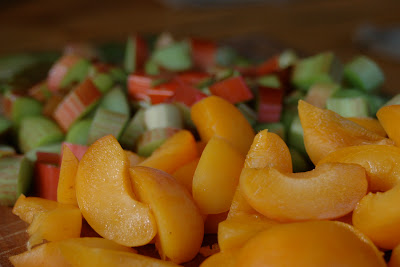People will tell you a lot of things about cobbler. They will tell you to add cornmeal to it, for
example, and that is fine. But they also
without any provocation or insult on your part against them will tell you to
use white bread instead of biscuit dough, or to cook the fruit on top of the
crust, to use pie crust instead of biscuit dough (hello! That’s called pie) or to cook the crust separately from the fruit. That was all the rage in Cobblertown some
years ago—cook an enormous biscuit on a baking sheet, and bake some fruit, and
right before you serve it, plop the one on top of the other. It’s true that in this way you escape the
dreadful fate of a biscuit that is undercooked on the bottom and burnt on the
top from your efforts to correct that situation underneath. But now what do you
have instead? Now you have a soggy
biscuit, and in my opinion you are no better off.
We make our way through a decent amount of cobbler in our
extended family. Two nephews out of
three prefer it to birthday cake. Here
is the only true thing I have learned about cobbler from reading: plop your
biscuit on top of piping hot filling and raw, doughy undersides are a thing of
the past.
For the biscuit I always use a recipe from a cookbook called
American As Apple Pie by Philip
Stephen Schulz, which offers 12 variations of 20 classic American dishes, like
chili and brownies and stew. Schulz has
a recipe for biscuits that cuts out the usual cutting-in of butter by
substituting heavy cream for both the butter and the milk. It kind of makes a boring biscuit on its own,
truthfully (his Buttermilk Skyscrapers are a much better option) but it is a
perfect way to make cobbler in a hurry, which is how you generally want to mix
up a cobbler.
Any fruit will do. I
don’t use much sugar because cobbler is usually a vehicle for the transfer of
large amounts of vanilla ice cream from carton to pie hole, and certain fruits
(or palates) may want more or less of the stuff. You can gild the lily by painting the top of
the biscuit with heavy cream and dusting it with sugar, but if time (or the
amount of cream on hand) don’t permit, you won’t miss it. A little lemon zest is nice in the biscuit, if
you think it is. Maybe a little minced
crystallized ginger in the fruit, too, if you have it. But plain is fine.
rhubarb-apricot cobbler
For the fruit:
about 5 c of sliced or chopped fruit
in this case here:
- 10-12 apricots, sliced (about 3 c)
- 3-4 stalks rhubarb, sliced (about 2 c)
½ c sugar
¾-1c fruit juice (I used pear; apricot would be good, too, or anything else that is handy), depending on the juiciness of your chosen fruit--I used the larger amount for this combo
3T minute tapioca
For the biscuit on top:
Scant cup of flour
2t baking powder
1t sugar
½ t salt
1 c heavy cream
Preheat the oven to 425 and butter a 10x10 baking dish.
Bring the rhubarb, sugar and fruit juice to a simmer in a
saucepan, and once it just starts to soften (it will suddenly lose its color,
by way of warning), sprinkle on the tapioca and mix in the apricots.
While this is underway, mix the dry ingredients for the
biscuit, and stir in the cream. You should have a wet dough. Add a little more cream or even some milk if
that is not what you have, and try to avoid a lot of mixing.
Pour the hot fruit into the prepared dish, and using wet
hands grab lumps of dough, flatten them, and glomp them on top of the
fruit. The dough rises plenty in the
oven and any weaknesses in your glomping plans will be mercifully overcome. You can brush the cream and sprinkle the
sugar on now, if you want to and time permits.
Bake about 25 minutes, until the top is nice and golden. Serve nice and warm, and eat the leftovers
for breakfast (so very similar in composition to a muffin that it kind of begs
for that deployment.)




No comments:
Post a Comment
This site has moved to araisinandaporpoise.com
See you over there!